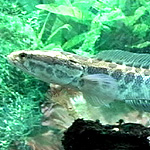2006年VOA标准英语-Scientists Study Asian Snakehead Invasion of Po(在线收听)
By Malcolm Brown
Washington, D.C.
24 November 2006
watch Snakehead report
An aquatic interloper appears to have adjusted easily to life in the Potomac River system near Washington, DC -- far from its native Asia, where it is regarded as a delicacy. The fierce-looking snakehead fish is far less popular in the United States, where scientists fear that it could damage local ecosystems. While snakeheads have achieved unusual notoriety, Malcolm Brown reports the Asian fish is just one example among many of what are described as 'invasive species'.
---
 |
| Snakehead fish can take over an ecosystem by devouring other fish species |
In the water is John Odenkirk, a biologist with the state of Virginia, who has watched the numbers rise. "The most likely scenario is that this population will expand for a period of time and then drop back to a lower level and stabilize, as this species kind of finds its niche in the system, as so many other exotics have done. Now, it's possible that it could be somewhat catastrophic. It's just impossible to say at this point."
Scientists have been studying the snakehead population closely to gauge its impact ever since anglers first started catching the voracious predator in the Potomac and its tributaries in 2004. It is thought the snakeheads -- dubbed by the media as "Frankenfish" -- may have been introduced by an aquarium owner, or by someone looking to establish a new food resource.
The worry is that snakeheads like to eat other fish. Angling is a major sport on the Potomac and, consequently, big business.
It's how Steve Chaconas makes his living as a fishing guide. "Bass fishing here on the Potomac is really big. The Potomac is considered by a lot of the guys and pretty much industry people as one of the top five bass fisheries in the country. What that translates to is every year you have a couple of top professional bass tournaments here that bring in a lot of money into the local economies."
Anglers worry that the snakeheads will eat young bass and compete for food, so they're doing their part to keep numbers down.
Derek Radoski is aiming to become an expert snakehead fisherman, but with some trepidation.
"I am concerned about promoting the sport of snakehead fishing that people would move the snakeheads to other bodies of water to make it a sport there as well. So, that's not what I am looking to do. But to say that I am pleased about it; no, but it's a hell of a fun thing to do on the weekend, when I am not selling security equipment Monday through Friday."
Since their arrival in these waters, snakeheads have captured a lot of attention, but they are far from the only interloper in the region's waters.
Scientist Greg Ruiz studies invasive species for the Smithsonian Environmental Research Center. For him, the discovery of Chinese mitten crab in the nearby Chesapeake Bay earlier in the year is potentially worrying, but not surprising.
"We know of hundreds of non-native species that are established in our bays and estuaries. When you include fresh water, the number goes up; 500 to 1,000 perhaps."
An increase Ruiz attributes to the effects of globalization. "The number of non-native species arriving to our waters in North America is going up dramatically over time. Many people believe that's driven by trade; increasing trade, increasing opportunities for organisms to be moved around."
For those looking to stem that tide, the snakehead's success so far is not encouraging.